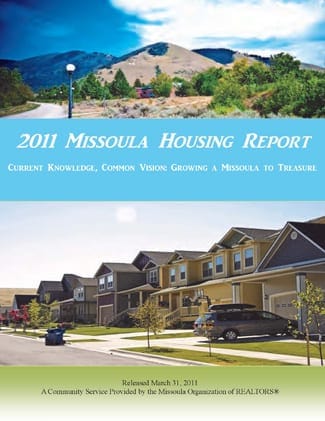 Today, both a pessimist and an optimist could find persuasive indicators to satisfy their outlooks for the Missoula housing market.
Today, both a pessimist and an optimist could find persuasive indicators to satisfy their outlooks for the Missoula housing market.
The pessimist might cite data indicating a continuation of the downturn, such as the still-declining annual number of existing home sales, the now 6-year slide in the number of single family building permits issued by the City of Missoula, the persistently high county unemployment rate, and continuing declines in inflation-adjusted income.
The optimist might counter by pointing to data giving hints that a meaningful recovery in the local housing market and the overall economy may at last take hold, such as the year-long 2011 increase in median sale prices of existing homes, an all-time historic low in mortgage interest rates, signs of a clearing from the home sales market of foreclosures and short sales, and late-2011 plus early-2012 declines in unemployment at all levels – local, state, and national.
Clearly, the data send mixed signals. But that, in itself, is a hopeful sign, as the past three of our annual reports to the community, for 2009 through 2011, contained very little data supporting an optimist’s perspective on the near-term future. Today, for example, much more so than in recent years, we can have greater confidence that our housing market, as well as our overall economy, is likely to escape a ruinous “double-dip” downturn.
Which is not to say that we are free of grave concerns – perhaps most prominently, affordability of decent housing. While our local housing market, like the national market, has seen several years of increasing affordability, the impact of those gains in Missoula has been much weaker than in the U.S. as a whole.
In this regard, the local rental market is especially worrisome. Rental prices, both in our region and nationally, have firmed considerably over the past year. Though the increase is moderate, it exceeds the inflation rate, while income gains have lagged the inflation rate. And in this time of severely strained government budgets, prospects for increased assistance from public programs – locally, statewide, or nationally – are at best dim and at worst nil.
Harvard’s State of the Nation’s Housing 2011 observes that “income gains have lagged housing costs for decades for an increasing share of renter households, and affordability pressures are making their way up the income scale. Rising demand is already pushing rents higher while stubbornly high unemployment is keeping the lid on wage increases. If these trends continue, affordability problems will worsen as the economy recovers.”
Concerning that economic recovery, one of the few certainties the data provide is that it is the weakest ever experienced – in no small measure owing to the absence of a pronounced turnaround in housing. For most Americans, the Great Recession’s officially declared end-date of June 2009 and 34 months since of recovery seems ludicrous.
Experts at the national and local levels have been confounded by the feebleness of recovery. Billionaire investment guru Warren Buffett admitted in February 2012 that he was “dead wrong” in his 2011 forecast that the U.S. housing market would begin to recover by now. In the same month, Patrick M. Barkey, Director of the Bureau of Business and Economic Research (BBER) at the University of Montana, said that Montana’s economic recovery “remains stuck at the starting gate” – citing data showing that the state’s economy actually slowed down in 2011 after having grown in 2010 (Big Sky Business Journal, Feb. 21, 2012).
Nonetheless, our consensus opinion remains, as in the past, that the Missoula market has telling advantages that help us cope better in these difficult times. One of these is the lesser severity of decline locally versus nationally, in the overall economy generally and in the housing market specifically. Another advantage is that Missoulians are resilient and pragmatic people: When confronted with challenges such as those of recent years, we collectively roll up our sleeves and say, “Let’s make things better.”
In 2011, particularly its final months, and early 2012, we began to see signs of success in that effort. With your help, those signs will proliferate this year and beyond.


